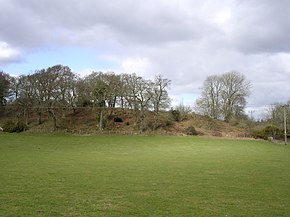Buckland Rings

Southern ramparts of Buckland Rings
|
|
| Location |
Lymington, Hampshire grid reference SZ314968 |
|---|---|
| Coordinates | 50°46′13″N 1°33′19″W / 50.77022°N 1.55525°W |
| Type | Hillfort |
| Area | 2.8 hectares |
| Height | 2.4 metres |
| History | |
| Periods | Iron Age |
| Site notes | |
| Excavation dates | 1935 |
| Archaeologists | Christopher Hawkes |
| Condition | Damaged on the east and west sides |
| Ownership | Hampshire County Council |
| Public access | Yes |
Buckland Rings is the site of an Iron Age hill fort in the town of Lymington, Hampshire. Today, the mounds and dykes around the outside which once constituted its defences are still clearly visible, although the outer bank lies under the road on the west side, and on the south-east it is nearly ploughed-out. Excavations of the inner and middle ramparts in 1935 revealed that they were of wall-and-fill construction, retained at the front by upright timber beams and walls of cut and laid turf. The entrance, which lies on the east side, was also excavated revealing a long entrance passage and the postholes for a pair of stout gateposts. The site was bought by Hampshire County Council in 1989 to ensure its preservation, and it is open to the public from the A337 road onto which part of it faces.
Buckland Rings is a triple-banked, rectangular encampment dating from the Iron Age. Although this type of enclosure is commonly referred to as a hillfort, Buckland Rings is in fact only 27 metres above sea-level. This type of site is rare in lowland areas and as such it is the best preserved and most important in the Hampshire/Dorset basin. It stands on a spur of gravel and encloses 2.8 hectares. The innermost bank stands 2.4 metres high whilst the middle one is lower but unusually wide. Buckland Rings has well-preserved triple banks and double ditches, although the outer bank lies under the road on the west side, and the east side which contained the entrance was partly ploughed up in the mid 18th century.
The earliest report of Buckland Rings was by Thomas Wright who visited the site in the summer of 1743. He described Buckland Rings as "very strong, with double ditches, and triple Vallums, upon the Top of an Hill, three Ways guarded by a natural Ascent." Wright drew a plan of the fort, which is especially valuable as some of the eastern ramparts were flattened by a farmer around 1750. Wright also noticed the presence of a lower camp nearby (Ampress Camp) together with a farm called Ampress Farm, which he understood to be "Ambrose Farm", and he thought that it was "not improbable" that the site was "a principal station" belonging to the 5th-century Romano-British war-leader Ambrosius Aurelianus.
...
Wikipedia

